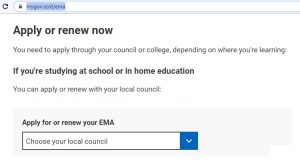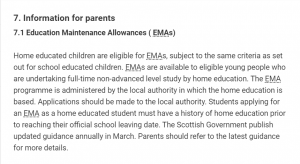Child benefit, tax credits, EMA and home education
Tax credits (to be replaced by Universal Credit) and Child Benefit are UK-wide benefits which can be claimed by eligible home educating families whose children are continuing in elective home education. The Education Maintenance Allowance, on the other hand, is only available to home educated children in Scotland who meet the eligibility criteria.
Child Benefit & Tax Credits
In June 2020, the UK Government updated its post-16 Child Benefit eligibility criteria:
Child Benefit when your child turns 16
Your Child Benefit stops on 31 August on or after your child’s 16th birthday if they leave education or training. It continues if they stay in approved education or training, but you must tell the Child Benefit Office.
Approved education
Education must be full-time (more than an average of 12 hours a week supervised study or course-related work experience) and can include:
-
-
- A levels or similar, for example Pre-U, International Baccalaureate
- Scottish Highers
- NVQs and other vocational qualifications up to level 3
- home education – if it started before your child turned 16 or after 16 if they have special needs
- traineeships in England
-
Courses are not approved if paid for by an employer or ‘advanced’, for example a university degree or BTEC Higher National Certificate.
Tell the Child Benefit Office if your child is:
The topic of tax credits and child benefit for home educators is one which has been regularly visited on our discussion forums, as families frequently find one or both benefits wrongly withdrawn as soon as their child reaches 16. Having previously contacted the HMRC press office to point out what has become routine mis-application of the regulations, we have been assured training will be improved and the manual for call centre staff changed. It just never seems to happen.
It should of course be straightforward to demonstrate eligibility, but it usually isn’t, so it’s always best to be prepared for the inevitable obstacle course that seems to be specially reserved for home educators. In the event that you meet with a brick wall, we strongly recommend contacting your MP to help focus bureaucratic minds.
The following information should hopefully be useful for those making their way through the HMRC maze.
Contrary to what under-trained call centre staff may tell you…
HMRC guidance which applies to tax credits and child benefit eligibility in respect of qualifying young people recognises elective home education, including autonomous home education, as “approved” education as long as it is “continuing”.
These HMRC guidance notes state on page 10:
“We may be able to pay Child Benefit for a young person if they continue their non advanced further education at home. However, education at home must have started before the young person reached age 16.”
The same definitions apply for tax credits.
For further reference, see:
CCM18030 – Child Benefit and Tax Credits: Definition of Full Time Education: “Main difference, if any, to Child Tax Credit (CTC) These definitions are the same for Child Tax Credit. See TCTM02230.”
CCM18035 – Child Benefit and Tax Credits: Definition of Approved Training: “Main difference, if any, to Child Tax Credit (CTC) This definition is the same as the definition for Child Tax Credit. See TCTM02230.”
[This section was last updated on 9 July 2020]
Education Maintenance Allowance (EMA)
In 2004, home educators in Scotland successfully argued for their inclusion in the Education Maintenance Allowance (EMA) scheme, which was subsequently afforded a dedicated section in the home education guidance.
It should be noted that the EMA, which is administered by the Local Authority, is not available to home educated students in England and Wales. For more information, please refer to the EMA Scotland website* and/or contact your Local Authority.
* Link now redirects to the my.gov site, which fails to mention home education, but the original guidance has not to our knowledge been amended (link accessed August 2020)
** After we and Home Education Scotland raised concerns over inaccuray with the Scottish Government, the mygov.scot site has been updated to correctly include home education. (April 2021)
 The following excerpt is from previously published EMA (Scotland) Guidance:
The following excerpt is from previously published EMA (Scotland) Guidance:
9. STUDENTS IN HOME EDUCATION
EMAs will be available to eligible young people who are undertaking full-time non-advanced level study by home education. The EMA programme will be administered for these students by the local authority in which the home education is based. Applications should be made to the local authority. In relation to the efficiency and suitability of education being delivered at home, local authorities should take into account the current Scottish Government guidance (www.scotland.gov.uk), and the local authority’s own guidance, where available.
Please note: Students applying for an EMA as a home educated student must have a history of home education prior to reaching their official school leaving date. The onus is on the applicant to provide evidence of a history of home education.
The programme for EMAs across the local authority and FE sectors is largely the same. This will also be the case in relation to home education. However, given the nature of home education, there will be particular elements of the programme which will vary. This section sets out those elements.
9.1 ELIGIBILITY OF STUDENT
Students who are home educated will be subject to the same age criteria as students in the schools and FE sectors (see Section 4.1). Students will become eligible for an EMA from the start of the local authority school term under the autumn or winter intake, as appropriate. While it is recognised that home education may not follow the same terms as school or college education, this will ensure all eligible local authority students begin to receive their EMA at the same point in the year, regardless of the form of education they are undertaking.
Home educated students will also be eligible to a maximum of 42 weeks of EMA support over the year in the same way as other students who are awarded an EMA.
9.2 ELIGIBILITY OF LEARNING
Eligible students can be home-educated full-time, or in conjunction with attendance at an institution (as recognised in Section 3.5). The local authority should be content that the home education is efficient and suitable for the child, and on a full-time basis.
The learning should be at non-advanced level. If the student attends college courses part-time as part of their home education programme, this should also be at non-advanced level.
9.2.1 ATTENDANCE REQUIREMENTS
In order to be eligible for the weekly allowance home educated EMA students will be required to meet the 100% attendance requirement.
Responsibility for ensuring 100% attendance in home education will lie predominantly with the education provider, and local authorities should refer to their existing policy on home education to ensure this is appropriate. Where a student also attends a part-time college course as part of their programme, they will be required to meet the 100% attendance criteria for that course (with usual reference to Section 7 Guidance on Absences).
9.2.2 PROGRESSION AND QUALIFICATIONS
Home educated students may not be working towards a recognised qualification. However, the programme of learning should be appropriate to the age, ability and aptitude of the student. Local authorities may choose to ensure that this remains the case throughout the student’s period of eligibility.
9.3 LEARNING AGREEMENT
In order to receive an EMA, all students must have a signed learning agreement (or equivalent) in place. For home educated students, this may be a plan of education agreed between the responsible adult and the student.
The education provider should submit a learning agreement or similar plan of education provision to the local authority as part of the application for an EMA. Once the local authority is satisfied that this meets the EMA Scotland Guidance on Learning Agreements (as Section 6 and below), the EMA should be granted.
9.3.1 REQUIRED SIGNATURES
The learning agreement (or equivalent) should be signed by the child and the adult educator or parent responsible, and by a representative of the local authority if required. Where the student attends college part-time the learning agreement should also be signed by an appropriate representative of the institution. All signatories should understand fully their responsibilities within the agreement. The responsible parent/education provider should ensure the learning agreement is clear and unambiguous about the proposed programme of learning.
9.3.2 REQUIREMENTS
The learning agreement (or equivalent) should incorporate the main features as outlined in Section 6. However, this should allow for the nature of home education, e.g. that home education may not lead to a recognised qualification. References may be incorporated to documents where such things as timetabled learning programmes are set out, but this is not a prerequisite given the alternative nature of many forms of home education. Learning Agreements may also reference the guidance for local education authorities in dealing with home educators, and may incorporate the suggested characteristics of an efficient and suitable education.
It remains the education provider’s responsibility to ensure that all the criteria of the plan of education outlined in the EMA application are met. Local authorities may seek details of the provision as per their normal responsibilities as outlined in the Scottish Government guidance, but should not seek to impose school or college structures, programmes or outcomes. If concerns are raised regarding the efficiency and suitability of the programme provided, then local authorities should investigate as normal and if these are justified then the EMA allowance may be withheld or reviewed.
9.3.3 WITHHOLDING PAYMENTS
Education providers (for example, parents) will be required to advise local authorities to withhold payments in any week where the student does not meet the attendance criteria or other requirements set out in the learning agreement.
9.3.4 RETENTION CRITERIA
For home educated students, this would be a return to their agreed learning programme.
9.3.5 PROGRESSION/ATTAINMENT CRITERIA
As students who are home educated may not be working towards a recognised qualification, there should be scope for variation to suit different home education expectations and capabilities of students.
9.4 MANAGEMENT INFORMATION
Local authorities should refer to Scottish Government guidance on the Management Information requirements for the EMA Scotland programme, and to Section 9.2 (i) and Section 9.4 above.
Local authorities should also make reference to existing policy in relation to contact with home educated pupils. The education provider will be responsible for informing the local authority when a student fails to meet the requirements for the weekly allowance, or otherwise stops being eligible for an EMA. Again, local authorities should refer to existing policy on this.


